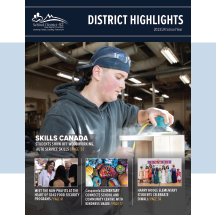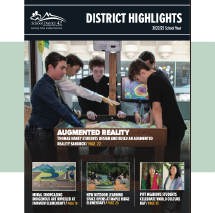Grade 6/7 students at Maple Ridge Elementary learned how to write their own meaningful land acknowledgements as part of Truth and Reconciliation Week.
“A land acknowledgement is a recognition of us understanding the past, present and future,” explained Shelby Henry, an Aboriginal resource teacher with the district. “So that we recognize the past harms, the present work that we’re doing and the future reconciliation.”
Henry, who is Anishinaabe, led the hour-long lesson on Monday morning. She taught the students the importance of land acknowledgements and explained why they need to be meaningful.
“We want to get out of that scripted statement where, OK, this is what we have to do at the beginning of this assembly, meeting or event. We need to get out of that script and we need to bring meaning to it,” she said.
How you do that, Henry explained, is by understanding the history, the colonial harms and injustices Indigenous communities have faced for many years. It’s acknowledging the territory and the deep, meaningful connection Indigenous peoples have to the land.
The acknowledgements the students wrote all began with the same text. The protocol:
I would like to acknowledge that Maple Ridge Elementary School is located on the shared, traditional and unceded territory of the Katzie First Nation and Kwantlen First Nation.
“After we say that protocol, which is important, then we get to our meaning,” Henry said. “Why is [the land] meaningful to us? And then bring it back to the Indigenous people taking care of it, the caretakers, and how thankful we are of them taking care of the land.”
Brynnley, one of the Grade 6 students in the class, wrote about how grateful she was for the land in her acknowledgement.
“I promise to protect this land because it is very special,” Brynnley wrote. “We say thank you for sharing the land, the trees, the traditions, the moss and the water. And for that, I am very grateful to the Katzie First Nation and the Kwantlen First Nation.”
Meanwhile, Isla, who is in Grade 7, wrote: “We need to not forget that we treat the land as we treat each other. We say thank you because the land that we stand on was not always the same. We must all protect the land that we live on. This land is borrowed and not owned.”
Grade 6 student Max wrote about the injustices faced by Indigenous communities.
“The land was unfairly taken from the Indigenous people when the government came to take over and take the Indigenous children away,” she wrote. “The Indigenous people lost so much from their language and traditions. Their identity was taken away when the government broke the peace that the Indigenous people had with the spirits of nature, with the plants and everything on the land.”
“We need to put effort, care, time and heart into the land acknowledgements because it’s more than that,” Max continued. “It’s understanding that what we did in the past was wrong… cruel, unjust and scarring. We need to show them that we are ready to listen, we’re ready to care.”


